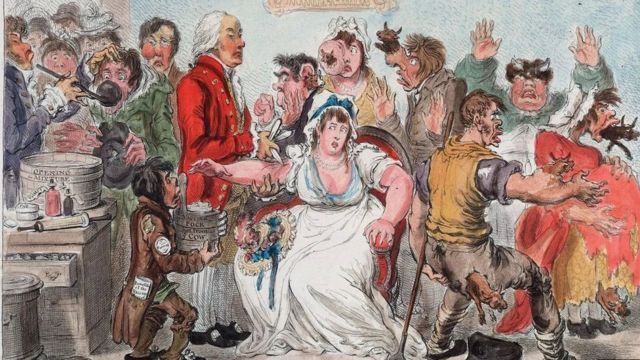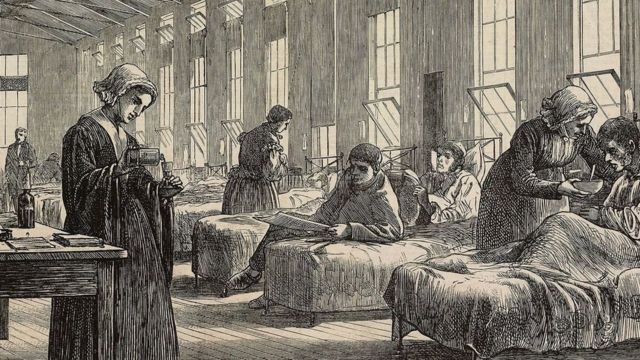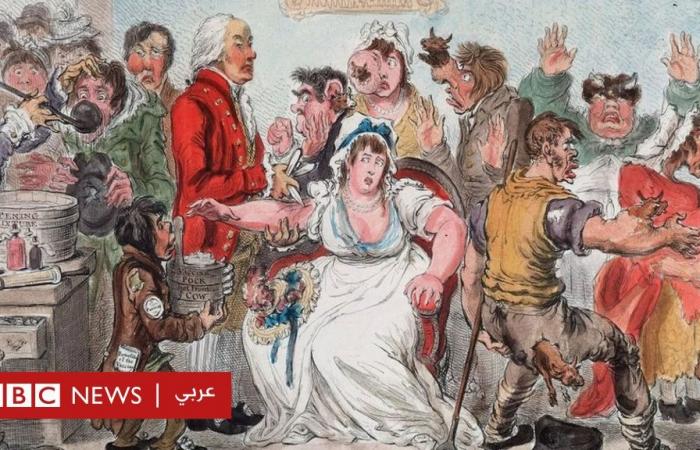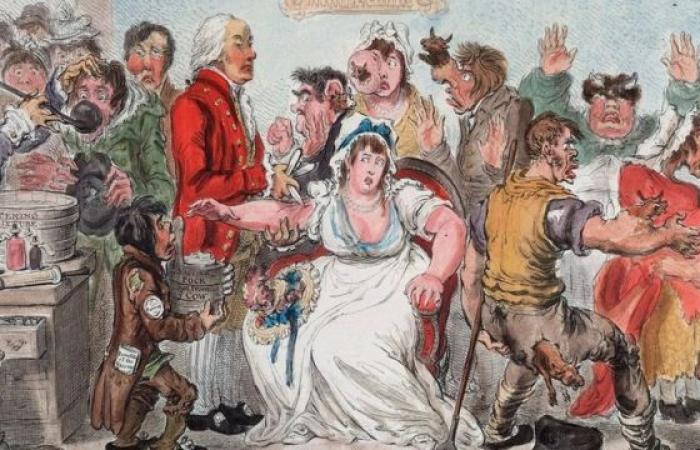- Richard Hollingham
- BBC
3 hours ago

Image Released, Getty Images
Smallpox was a terrible disease. “You feel excruciating pains in your body, accompanied by fever, sore throat, headache, and difficulty breathing,” describes it, Rene Nagera, the epidemiologist and editor of the website “History of Vaccines”, is a terrible disease.
But worse than that, according to Nagira, is: “An ugly rash spreads all over your body, taking the form of festering blisters on the scalp, feet, throat and even the lungs. Then they dry out over two days and fall off the scales.”
Global trade and the expansion of empires played a big role in spreading smallpox around the world. The disease was so deadly that it killed about a third of all adults and eight out of 10 children. And at the beginning of the eighteenth century, the disease was killing about 400 thousand infected people annually in Europe alone.
The harbors were more vulnerable to the epidemic, and in 1721, smallpox broke out in Boston, USA, and killed eight percent of its residents. As for the survivors, the disease used to leave scars that haunt them throughout their lives, such as blindness and disgusting scars.
“When the scales fall off, you leave deep scars that distort your face, to the extent that some people have opted for suicide over living with these scars,” Nagira says.
There were many treatments for smallpox, and some of them were useless and some were strange (but in the end it was also useless), and these treatments included placing the injured in hot rooms or sometimes cold rooms, refraining from eating watermelon, and wrapping the patients’ bodies with a red blanket. In the seventeenth century, one of the recipes required that the patient be given 12 small bottles of beer every 24 hours, so that the drunkenness might alleviate the pain.
But in the midst of these treatments, a real cure for the disease, known as “variolation” or vaccination against smallpox, has spread, and it involves extracting pus from the blisters of a person with smallpox and inserting them into superficial wounds on the skin of another healthy person, or grinding the scales of pimples from a sick person and inserting it into the nose of a healthy person .
These methods were practiced at first in Africa and Asia, then they were carried to Europe and North America by a slave called Onesimus in the eighteenth century. Inoculation against smallpox usually reduced the severity of the disease, but not always. Some people had all the severe symptoms of smallpox, and all people who had this type of vaccination became carriers of the disease, and they accidentally passed it on to others.

Image Released, Getty Images
Before Jenner’s research, there were many treatments for smallpox, some of them useless and some of them weird
In the early 18th century, it was rumored that a group of people in the English countryside were immune to smallpox. Rural women who milked cows contracted cowpox, a milder form of smallpox that infects cattle and leaves few scars.
When a smallpox epidemic broke out in western England in 1744, farmer Benjamin Jisti came up with a new idea for immunization. He extracted some pus from the sores on the udder of a cow infected with cowpox and inserted it into superficial wounds on the skin of his wife and children, and none of them had smallpox.
No one heard of Jesty’s experience until many years later. Edward Jenner, who is credited with inventing and promoting vaccines, made similar observations and conclusions.
Jenner was a rural doctor working in Berkeley, County Gloucestershire, and was a student in London from the most talented surgeons of his time. Jenner’s interest in smallpox treatment is said to be due to his dreadful childhood vaccination.
It is said that his horror from this experience prompted him to search for a smallpox vaccine. “Jenner was trying to find an alternative that was safer and less intimidating (than the popular restoration process at the time),” says Owen Goyer, director of the Dr. Jenner House Museum.
And in 1796, after collecting evidence from male and female farmers milking cows, Jenner decided to run an experiment, but it was dangerous, by running it on a child.
Jenner extracted pus from a wound on the hand of a young milking cows infected with cowpox, Sarah Nilmes, and slapped it on the skin of eight-year-old James Phipps. The child suffered slight symptoms for a few days, and after he recovered, Jenner injected him with a substance he extracted from the blisters of a person with smallpox. Neither James nor any of the people he had contacted had smallpox.
Although the experiment was successful, by today’s standards it may raise many ethical issues.

Image Released, Getty Images
Edward Jenner, whose memorial is immortalized by a statue of him impregnating his son, overlooked ethical concerns to explore how cowpox vaccine could save patients’ lives
Sheila Cruikshank, professor of immunology at the University of Manchester, says: “It was not a clinical trial, and perhaps choosing who would undergo a vaccine trial might cause concern.”
Jenner did not know the scientific basis for this discovery. No one realized at that time that smallpox was caused by the “variola” virus, and the role of the immune system in fighting the disease was still unknown.
“Many of Jenner’s experiments were based on stimulating an immune response, releasing antibodies and building immune memory, although these concepts have not yet been discovered. This is both amazing and terrifying,” Cruikshank says.
Jenner realized that the smallpox vaccine he had developed from cowpox had the potential to revolutionize preventive medicine and save patients’ lives. But he also knew that curbing the spread of the disease would depend on vaccinating the largest number of people possible.
Goyer says: “Jenner was not aiming to make money from the vaccine, and he did not care about protecting his discovery with a patent, and all he wanted was to introduce people to the vaccine and spread it among the people.”
That is why he transformed a wooden hut in his garden into a center for pollen testing, and invited townspeople to receive the vaccine every Sunday after leaving the church.
“Jenner has sent letters to other doctors, offering them samples of the vaccine and urging them to try it for themselves so that all people get the vaccine from trusted doctors in their hometowns. This reminds us of the vaccination campaigns that vaccine advocates are practicing to convince people of their importance in protecting against disease,” Goyer says.

Image Released, Getty Images
It is estimated that smallpox disease in the nineteenth century killed 400,000 people annually in Europe alone
After Jenner published the results of his research, news of the discovery spread throughout Europe, and then the King of Spain helped him spread it around the world.
King Charles IV of Spain had lost many of his family members to smallpox, and the disease left deep scars and scars on some others, including his daughter Maria Luisa. As soon as he heard about the Jenner vaccine, he assigned a doctor to lead a global humanitarian mission to distribute it to the population in the farthest reaches of the Spanish Empire, although these regions of the world did not spread smallpox until after the European colonialists invaded them.
In 1803, a ship sailed to South America, carrying 22 orphaned children to take on the role of vaccine carriers.
Nagira says: “There were no ways to manufacture vaccines on a large scale, and that is why they gave the vaccine to a child, until he had mild symptoms of the disease, then they extracted the pus from the sores and wounds on his skin after two days, and gave it to another child and so on.”
Isabel Gomez, director of the orphanage, took care of the children throughout the trip and made sure to bring her son to participate in the mission.
From the Caribbean countries, the mission traveled to South and Central America, and crossed the Pacific Ocean to settle in the Philippines. Within 20 years of its discovery, the Jenner vaccine had saved millions of lives. Dole quickly distributed the smallpox vaccine to the population, until the disease was completely eradicated in 1979.
Nagira says: “Jenner’s experience gives me hope that a vaccine can be found against the emerging corona. Over 200 years we have acquired a lot of information about viruses and the immune system, while Jenner did not know any of this information and yet he achieved this achievement.”
“In my view Jenner is still one of the greatest heroes in the scientific field,” says Goyer. “His determination and ability to innovate has helped change the world and save countless millions of lives and still save lives.”
These were the details of the news Smallpox: a deadly disease that killed millions and led to the... for this day. We hope that we have succeeded by giving you the full details and information. To follow all our news, you can subscribe to the alerts system or to one of our different systems to provide you with all that is new.
It is also worth noting that the original news has been published and is available at eg24.news and the editorial team at AlKhaleej Today has confirmed it and it has been modified, and it may have been completely transferred or quoted from it and you can read and follow this news from its main source.





